Study of a Fire-Resistant Plate Containing Fly Ashes Generated from Municipal Waste Incinerator: Fire and Mechanical Characteristics and Environmental Life Cycle Assessment
Abstract
1. Introduction
2. Materials and Methods
2.1. Materials
2.2. Plate Manufacturing
2.3. Thermal Insulating Behaviour
2.4. Physical and Mechanical Properties
2.5. Environmental Life Cycle Analysis
2.5.1. Scope and Goal
2.5.2. Life Cycle Inventory and Sensitivity Analysis
2.5.3. Environmental Impact Assessment
3. Results and Discussion
3.1. Physical Properties
3.2. Thermal Insulating Capacity
3.3. Mechanical Properties
3.4. Environmental Life Cycle Analysis
Sensitivity Analysis
4. Conclusions
Supplementary Materials
Author Contributions
Funding
Institutional Review Board Statement
Informed Consent Statement
Data Availability Statement
Conflicts of Interest
References
- Chen, D.; Zhang, Y.; Xu, Y.; Nie, Q.; Yang, Z.; Sheng, W.; Qian, G. Municipal solid waste incineration residues recycled for typical construction materials. RSC Adv. 2022, 12, 6279–6291. [Google Scholar] [CrossRef] [PubMed]
- Mangialardi, T. Sintering of MSW fly ash for reuse as a concrete aggregate. J. Hazard. Mater. 2001, 87, 225–239. [Google Scholar] [CrossRef] [PubMed]
- Chimenos, J.; Fernández, A.; Cervantes, A.; Miralles, L.; Fernández, M.; Espiell, F. Optimizing the APC residue washing process to minimize the release of chloride and heavy metals. Waste Manag. 2005, 25, 686–693. [Google Scholar] [CrossRef] [PubMed]
- Chen, W.; Kikelund, G.M.; Jensen, P.E.; Ottosen, L.M. Comparison of different MSWI fly ash treatment processes on the termal behavior of As, Cr, Pb, and Zn in the ash. Waste Manag. 2017, 68, 240–251. [Google Scholar] [CrossRef] [PubMed]
- Maresca, A.; Bisinella, V.; Astrup, T.F. Life cycle assessment of air-pollution-control residues from waste incineration in Europe: Importance of composition, technology and long-term leaching. Waste Manag. 2022, 144, 336–348. [Google Scholar] [CrossRef] [PubMed]
- Chen, X.; Bi, Y.; Zhang, H.; Wang, J. Chlorides removal and control through water-washing process on MSWI fly ash. Procedia Environ. Sci. 2016, 31, 560–566. [Google Scholar] [CrossRef]
- Mangialardi, T. Disposal of MSWI fly ash through a combined washing-immobilization process. J. Hazard. Mater. 2003, 98, 225–240. [Google Scholar] [CrossRef] [PubMed]
- Wang, Q.; Yang, J.; Wang, Q.; Wu, T. Effects of water-washing pretreatment on bioleaching of heavy metals from municipal solid waste incinerator fly ash. J. Hazard. Mater. 2009, 162, 812–818. [Google Scholar] [CrossRef]
- Poranek, N.; Pizoń, J.; Łaźniewska-Piekarczyk, B.; Czajkowski, A.; Lagashkin, R. Recycle Option for municipal Solid Waste Incineration Fly Ash (MSWIFA) as a Partial Replacement for Cement in Mortars Containing Calcium Sulfoaluminate Cement (CSA) and Portland Cement to Save the Environment and Natural Resources. Materials 2024, 17, 39. [Google Scholar] [CrossRef]
- Marieta, C.; Martín-Garin, A.; Leon, I.; Guerrero, A. Municipal Solid Waste Incineration Fly Ash: From Waste to Cement Manufacturing Resource. Materials 2023, 16, 2538. [Google Scholar] [CrossRef]
- Rémond, S.; Pimienta, P.; Bentz, D.P. Effects of the incorporation of Municipal Solid Waste Incineration fly ash in cement pastes and mortars: I. Experimental study. Cem. Concr. Res. 2002, 32, 303–311. [Google Scholar] [CrossRef]
- Joseph, A.M.; Snellings, R.; Van den Heede, P.; Matthys, S.; De Belie, N. The Use of Municipal Solid Waste Incineration Ash in Various Building Materials: A Belgian Point of View. Materials 2018, 11, 141. [Google Scholar] [CrossRef]
- Mokrzycki, J.; Baran, P.; Gazda-Grzywacz, M.; Bator, J.; Wróbel, W.; Zarębska, K. Decarbonatization of Energy Sector by CO2 Sequestration in Waste Incineration Fly Ash and Its Utilization as Raw Material for Alkali Activation. Materials 2023, 16, 6094. [Google Scholar] [CrossRef]
- Liu, J.; Wang, Z.; Xie, G.; Li, Z.; Fan, X.; Zhang, W.; Xing, F.; Tang, L.; Ren, J. Resource utilization of municipal solid waste incineration fly ash cement and alkali-activated cementitious materials: A review. Sci. Total Environ. 2022, 852, 158254. [Google Scholar] [CrossRef] [PubMed]
- Cheng, Y.; Dong, Y.; Diao, J.; Zhang, G.; Chen, C.; Wu, D. MSWI Bottom Ash Application to Resist Sulfate Attack on Concrete. Appl. Sci. 2019, 9, 5091. [Google Scholar] [CrossRef]
- Liu, B.; Yang, Q.W.; Zhang, S.G. Integrated utilization of municipal solid waste incineration fly ash and bottom ash for preparation of foam glass-ceramics. Rare Met. 2019, 38, 914–921. [Google Scholar] [CrossRef]
- Lin, T.-H.; Siao, H.-J.; Gau, S.-H.; Kuo, J.-H.; Li, M.-G.; Sun, C.-J. Life-Cycle Assessment of Municipal Solid Waste Incineration Fly Ash Recycling as a Feedstock for Brick Manufacturing. Sustainability 2023, 15, 10284. [Google Scholar] [CrossRef]
- Li, E.; Zhang, X.; Wang, L.; Wang, R.; Zhang, W.; Chen, C.; Zhang, W. Performance of Asphalt Mastic and Asphalt Mixture with Harmless Municipal Solid Waste Incineration Fly Ash. Buildings 2023, 13, 498. [Google Scholar] [CrossRef]
- Korzeniowski, W.; Poborska-Mynarska, K.; Skzypkowski, K. The idea of the recovery of municipal solid waste incineration (MSWI) residues in Klodawa salt mine S.A by filling the excavations with self-solidifying mixtures. Arch. Min. Sci. 2018, 63, 553–565. [Google Scholar] [CrossRef]
- EN 13501-1; Fire Classification of Construction Products and Building Elements Part 1: Classification Using Data from Reaction to Fire Tests. European Committee for Standardization: Brussels, Belgium, 2019.
- Vilches, L.F.; Leiva, C.; Vale, J.; Fernández-Pereira, C. Insulating capacity of fly ash pastes used for passive protection against fire. Cem. Concr. Compos. 2005, 27, 776–781. [Google Scholar] [CrossRef]
- García Arenas, C.; Marrero, M.; Leiva, C.; Solís-Guzmán, J.; Vilches Arenas, L.F. High fire resistance in blocks containing coal combustion fly ashes and bottom ash. Waste Manag. 2011, 31, 1783–1789. [Google Scholar] [CrossRef]
- Peceño, B.; Pérez-Soriano, E.M.; Ríos, J.D.; Luna, Y.; Cifuentes, H.; Leiva, C. Effect of different ashes from biomass olive pomace on the mechanical and fire properties of gypsum-based materials. Rev. Construcción 2023, 22, 122–134. [Google Scholar] [CrossRef]
- Leiva, C.; Vilches, L.F.; Vale, J.; Fernández-Pereira, C. Fire resistance of biomass ash panels used for internal partitions in buildings. Fire Saf. J. 2009, 44, 622–628. [Google Scholar] [CrossRef]
- Peceño, B.; Pérez-Soriano, E.M.; Luna-Galiano, Y.; Leiva, C. The Incorporation of Ladle Furnace Slag in Fire Insulating Gypsum-Based Materials. Fire 2023, 6, 416. [Google Scholar] [CrossRef]
- Ríos, J.D.; Arenas, C.; Cifuentes, H.; Vilches, L.F.; Leiva, C. Development of a paste for passive fire protection mainly composed of granulated blast furnace slag. Environ. Prog. Sustain. Energy 2020, 39, e13382. [Google Scholar] [CrossRef]
- Peceño, B.; Alonso-Fariñas, B.; Vilches, L.F.; Leiva, C. Study of seashell waste recycling in fireproofing material: Technical, environmental, and economic assessment. Sci. Total Environ. 2021, 790, 148102. [Google Scholar] [CrossRef]
- Leiva, C.; Solís-Guzmán, J.; Marrero, M.; García Arenas, C. Recycled blocks with improved sound and fire insulation containing construction and demolition waste. Waste Manag. 2013, 33, 663–671. [Google Scholar] [CrossRef]
- EN 1097-7; Tests for Mechanical and Physical Properties of Aggregates Part 7: Determination of the Particle Density of Filler Pyknometer Method. European Committee for Standardization: Brussels, Belgium, 2009.
- Ontiveros, J.L.; Clapp, T.L.; Kosson, D.S. Physical properties and chemical species distributions within municipal waste combuster ashes. Environ. Prog. 1989, 8, 200–206. [Google Scholar] [CrossRef]
- Phua, Z.; Giannis, A.; Dong, Z.L.; Lisak, G.; Jern Ng, W. Characteristics of incineration ash for sustainable treatment and reutilization. Environ. Sci. Pollut. Res. 2019, 26, 16974–16997. [Google Scholar] [CrossRef]
- Wang, K.S.; Chiang, K.Y.; Lin, K.L.; Sun, C.J. Effects of a water-extraction process on heavy metal behavior in municipal solid waste incinerator fly ash. Hydrometallurgy 2001, 62, 73–81. [Google Scholar] [CrossRef]
- EN 13279-1; Gypsum Binders and Gypsum Plasters Part 1: Definitions and Requirements. European Committee for Standardization: Brussels, Belgium, 2008. [CrossRef]
- Vilches, L.F.; Leiva, C.; Olivares, J.; Vale, J.; Fernández, C. Coal fly ash-containing sprayed mortar for passive fire protection of steel sections. Mater. De Construcción 2005, 55, 25–37. [Google Scholar] [CrossRef]
- Leiva, C.; Arenas, C.; Vilches, L.F.; Alonso-Fariñas, B.; Rodriguez-Galán, M. Development of fly ash boards with thermal, acoustic and fire insulation properties. Waste Manag. 2015, 46, 298–303. [Google Scholar] [CrossRef] [PubMed]
- EN 1363-1; Fire Resistance Tests Part 1: General Requirements. European Committee for Standardization: Brussels, Belgium, 2021.
- EN 12859; Gypsum Blocks Definitions, Requirements and Test Methods. European Committee for Standardization: Brussels, Belgium, 2012.
- EN 1015-11; Methods of Test for Mortar for Masonry—Part 11: Determination of Flexural and Compressive Strength of Hardened Mortar. European Committee for Standardization: Brussels, Belgium, 2019.
- ISO 14044; Environmental Management—Life Cycle Assessment—Principles and Framework. International Organization for Standardization: Geneva, Switzerland, 2006.
- Sonderegger, T.; Stoikou, N. Implementation of Life Cycle Impact Assessment Methods in the Ecoinvent Database v3.10; Ecoinvent Association: Zürich, Switzerland, 2023. [Google Scholar]
- Bušatlić, I.; Bušatlić, N.; Merdić, N.; Haračić, N. Material and energy balance of production of gypsum. In Proceedings of the 13th International Research/Expert Conference “Trends in the Development of Machinery and Associated Technology” TMT, Hammamet, Tunisia, 16–21 October 2009. [Google Scholar]
- Fundación Labein. Guía Técnica para la Medición, Estimación y Cálculo de las Emisiones al aire. Ed. Soc. Pública De Gestión Ambiental del Gobobierno Vasco. 2005. Available online: https://www.euskadi.eus/contenidos/documentacion/eprtr/es_guia/adjuntos/residuos.pdf (accessed on 11 April 2024).
- Gencel, O.; Díaz, J.J.; Sutcu, M.; Koksal, F.; Rabanal, F.A.; Martinez-Barrera, G.; Brostow, W. Properties of gypsum composites containing vermiculite and polypropylene fibers: Numerical and experimental results. Energy Build 2014, 70, 135–144. [Google Scholar] [CrossRef]
- EC/532/2000; Replacing Decision 94/3/EC Establishing a List of Wastes Pursuant to Article 1(a) of Council Directive 75/442/EEC on Waste and Council Decision 94/904/EC Establishing a List of Hazardous Waste Pursuant to Article 1(4) of Council Directive 91/689/EEC on Hazardous Waste. European Commission: Brussels, Belgium, 2000.
- Mercante, I.; Bovea, M.; Ibáñez-Forés, V.; Arena, A. Life cycle assessment of construction and demolition waste management systems: A Spanish case of study. Int. J. LCA 2012, 17, 232–241. [Google Scholar] [CrossRef]
- Google Maps. Distances. 2024. Available online: https://www.google.com/maps/ (accessed on 11 April 2024).
- EC/715/2007; On Type Approval of Motor Vehicles with Respect to Emissions from Light Passenger and Commercial Vehicles (Euro 5 and Euro 6) and on Access to Vehicle Repair and Maintenance Information. European Commission: Brussels, Belgium, 2007.
- Goedkoop, M.; Oele, M.; Leijting, J.; Ponsioen, T.; Meijer, E. Introduction to LCA with SimaPro. Ed. PRE Consultants, 2016. Available online: https://www.pre-sustainability.com/download/SimaPro8IntroductionToLCA.pdf (accessed on 11 April 2024).
- Huijbregts, M.A.J.; Steinmann, Z.J.N.; Elshout, P.M.F.; Stam, G.; Verones, F.; Vieira, M.D.M.; Zijp, M.; Van Zelm, R. ReCiPe 2016 v1.1 A harmonized life cycle impact assessment method at midpoint and endpoint level Report I: Characterization. NIPHE (RIVM) Int. J. Life Cycle Assess 2017, 22, 138–147. [Google Scholar] [CrossRef]
- Salazar, P.A.; Fernández, C.L.; Luna-Galiano, Y.; Sánchez, R.V.; Fernández-Pereira, C. Physical, Mechanical and Radiological Characteristics of a Fly Ash Geopolymer Incorporating Titanium Dioxide Waste as Passive Fire Insulating Material in Steel Structures. Materials 2022, 15, 8493. [Google Scholar] [CrossRef]
- Leiva, C.; Gómez-Barea, A.; Vilches, L.F.; Ollero, P.; Vale, J.; Fernández-Pereira, C. Use of biomass gasification fly ash in lightweight plasterboard. Energy Fuels 2007, 21, 361–367. [Google Scholar] [CrossRef]
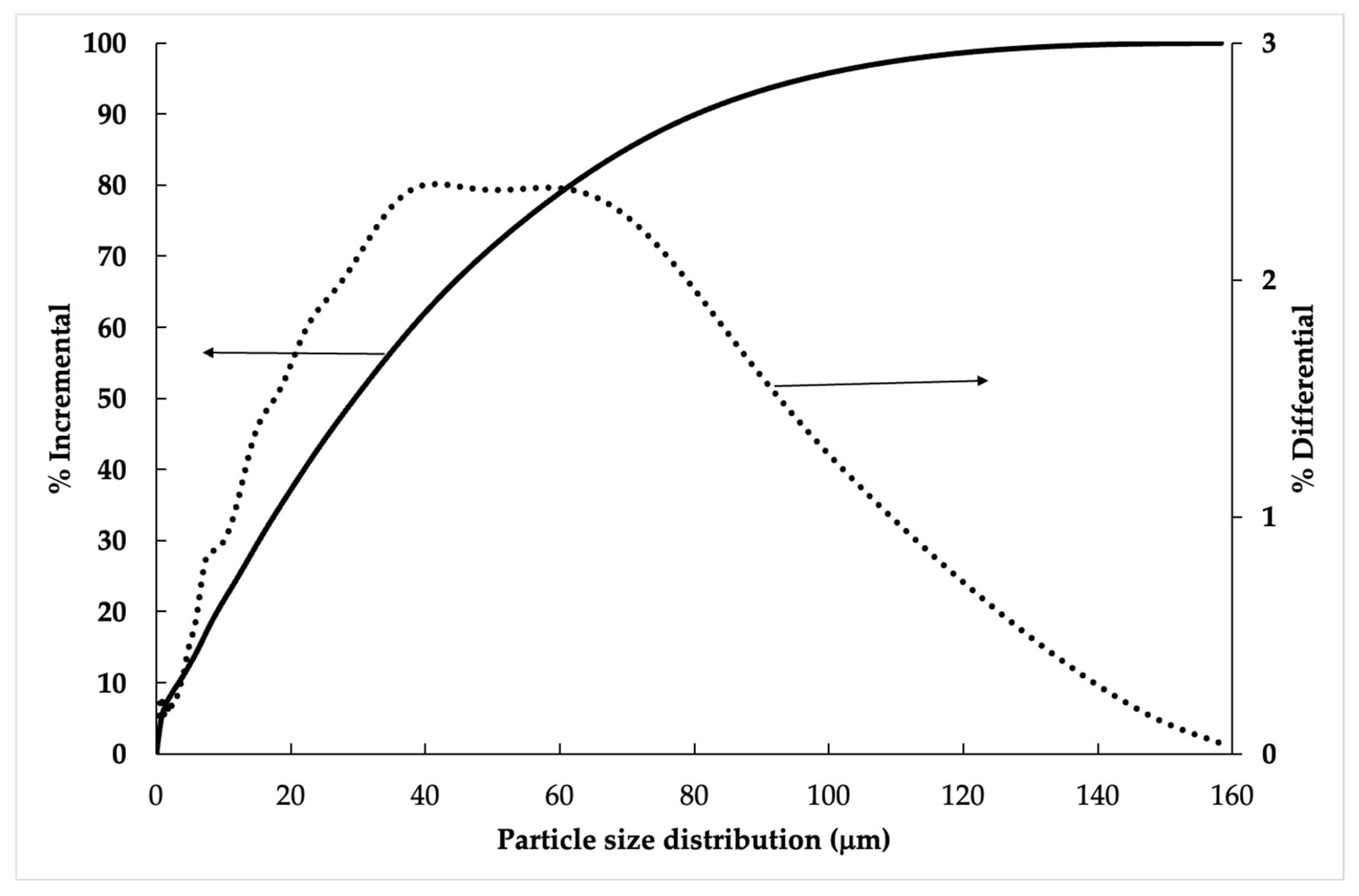
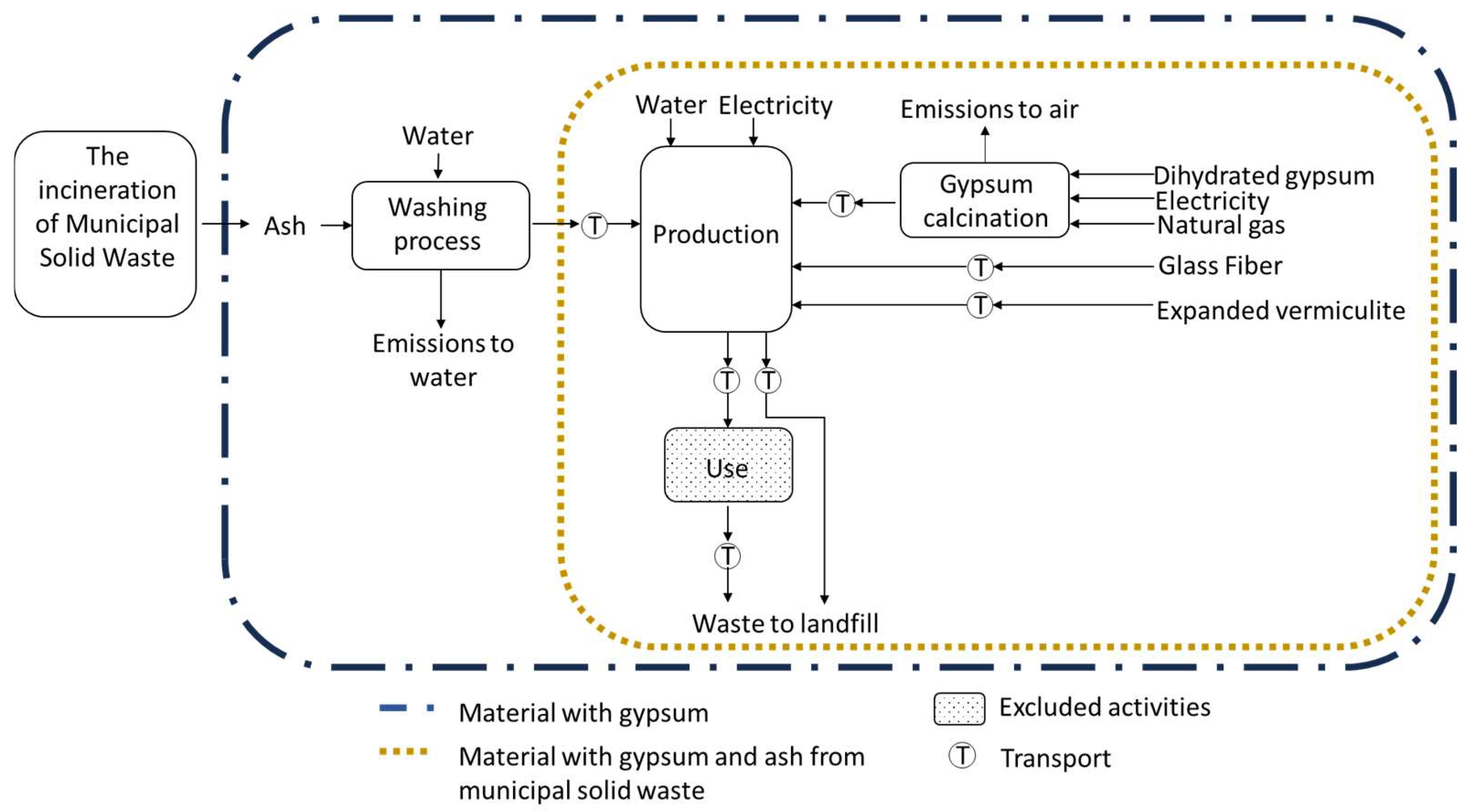

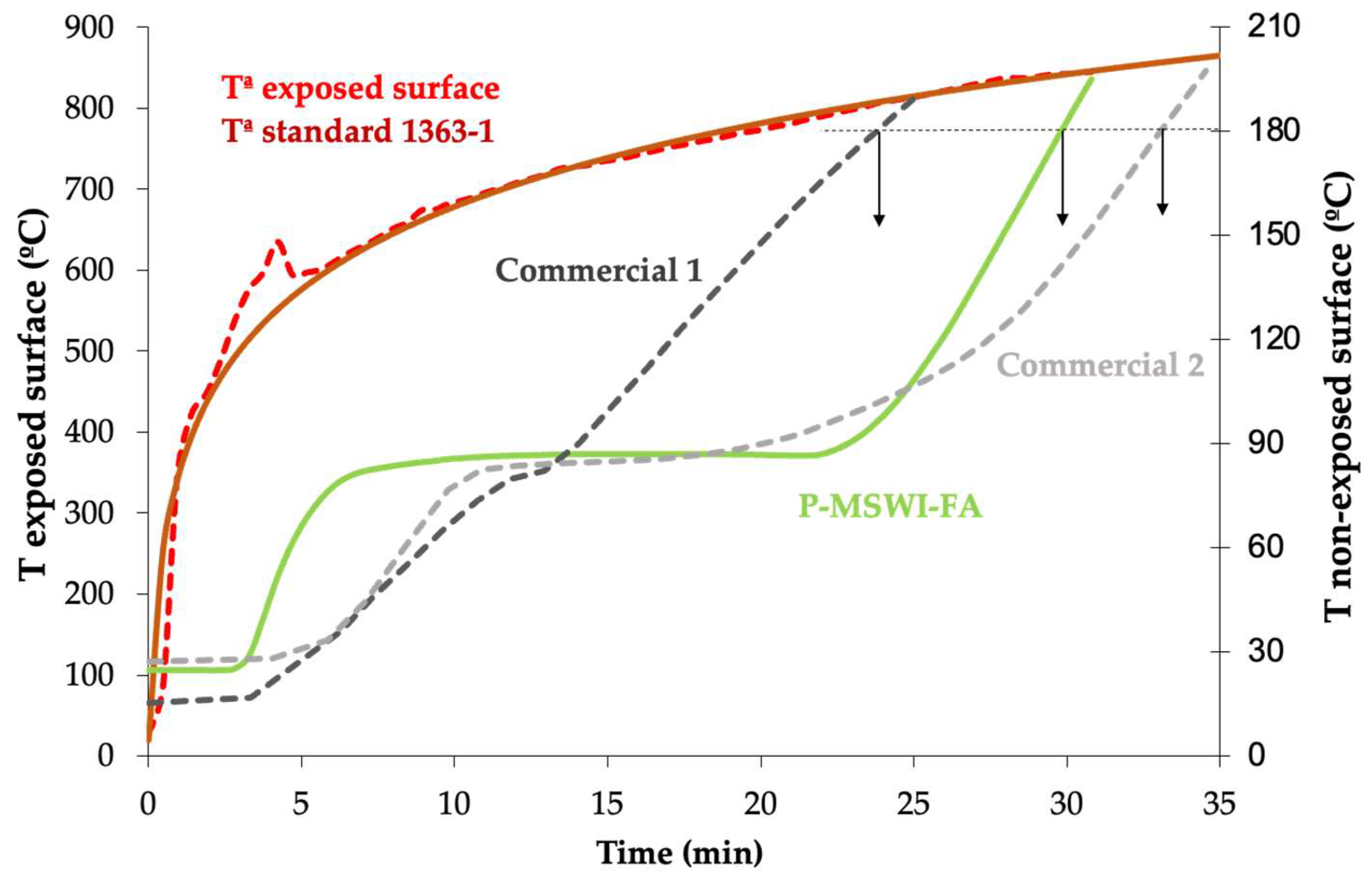

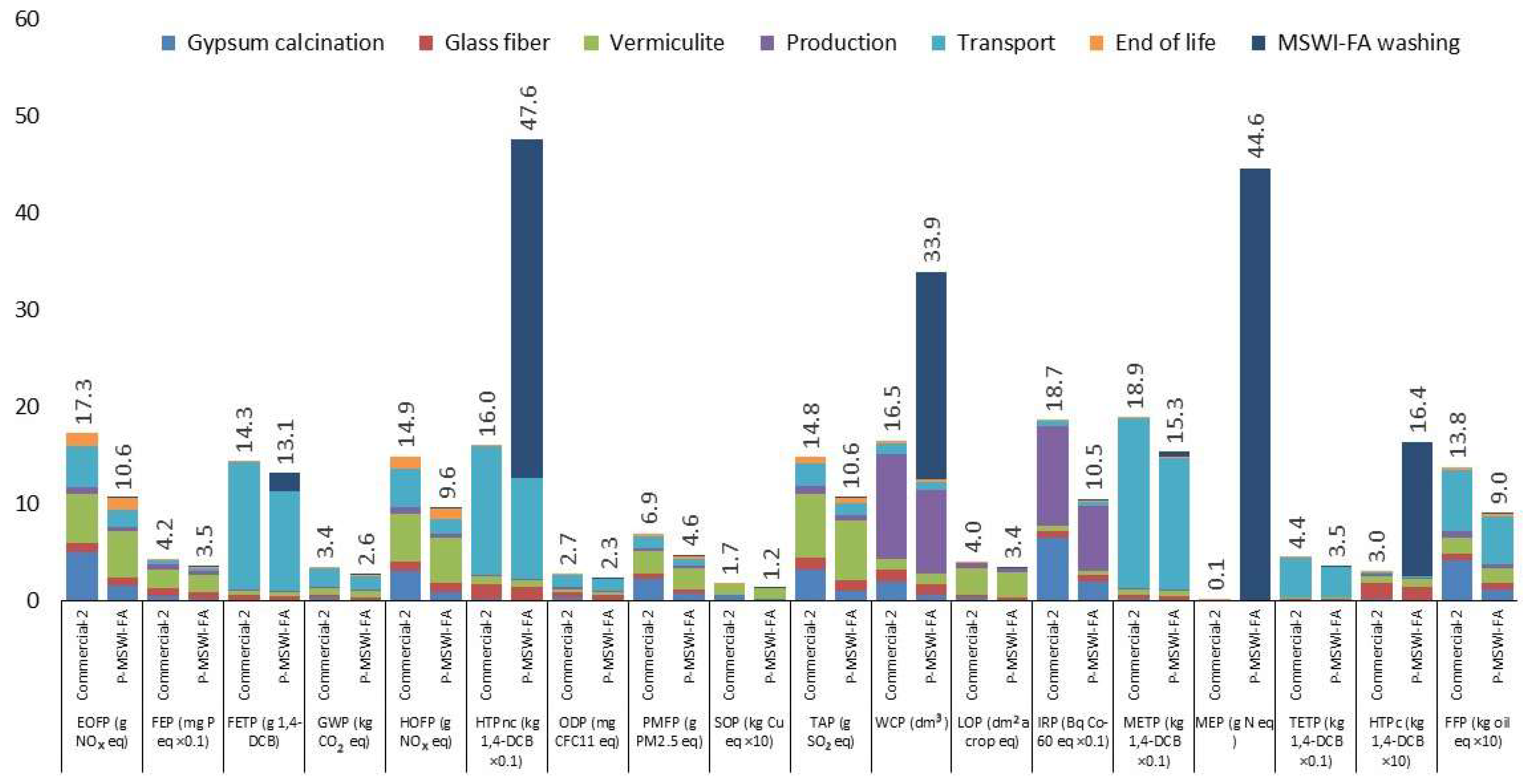
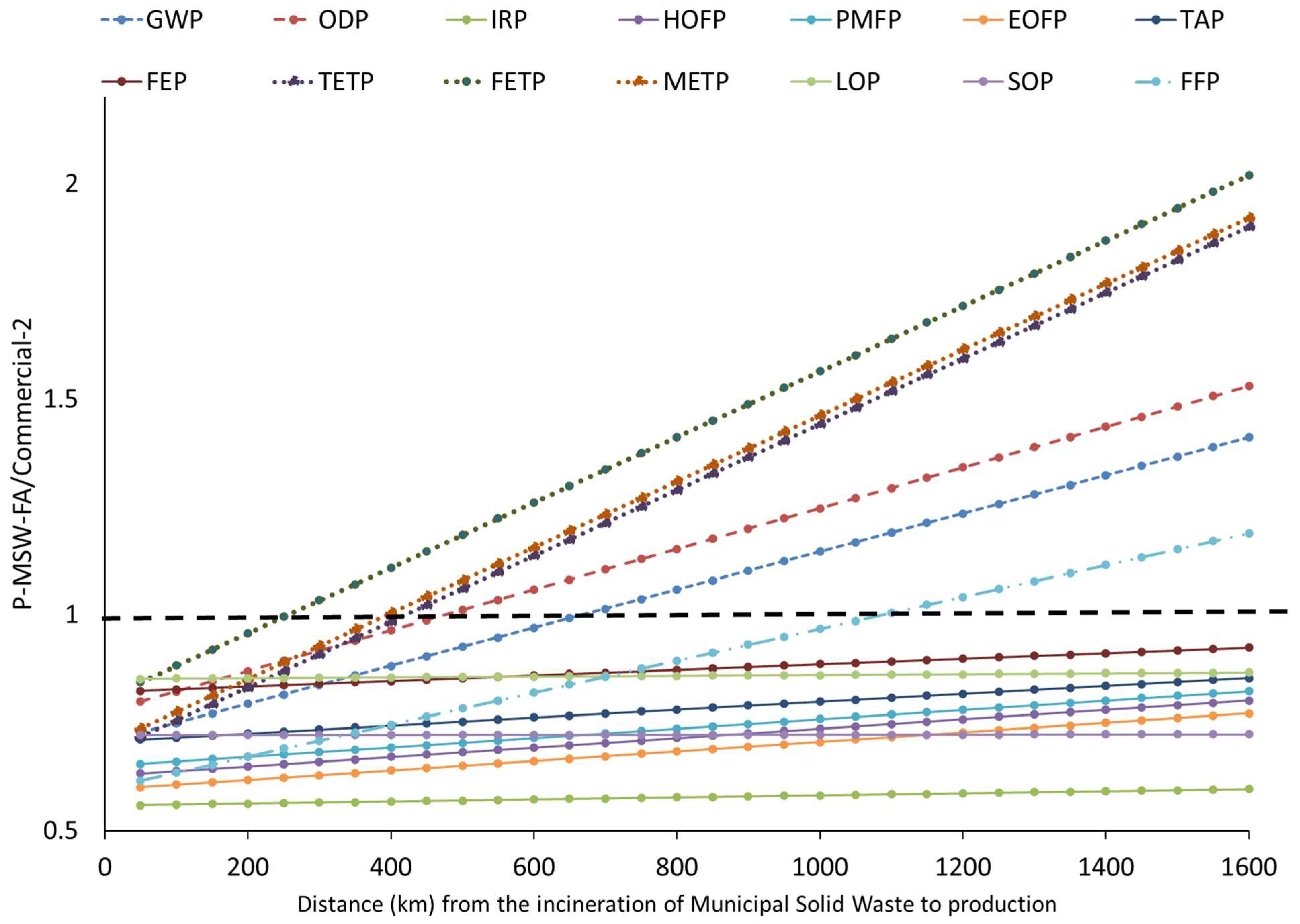
| Parameter | %wt |
|---|---|
| Specific gravity | 2.89 |
| Moisture | 3.04 |
| Loss on ignition | 18.42 |
| CaO | 37.06 |
| MgO | 1.37 |
| Fe2O3 | 0.86 |
| Al2O3 | 4.72 |
| SiO2 | 6.56 |
| K2O | 4.45 |
| Na2O | 6.72 |
| Cl | 12.17 |
| SO3 | 3.15 |
| MgO | 1.29 |
| ZnO | 1.41 |
| P2O5 | 0.76 |
| PbO | 0.45 |
| TiO2 | 0.46 |
| SnO2 | 0.15 |
| Material | Water/Solids Ratio | Glass Fiber (%wt) | Vermiculite (%wt) | Gypsum (%wt) | Ash (%wt) |
|---|---|---|---|---|---|
| P-MSWI-FA | 0.4 | 0.5 | 9.5 | 30 | 60 |
| Parameter | Compressive Strength (Rc, MPa) | Flexural Strength (Rf, MPa) | Superficial Hardness (D, Shore C) |
|---|---|---|---|
| P-MSWI-FA | 0.84 ± 0.2 | 0.73 ± 0.1 | 36 ± 0.6 |
| Section | Input Flow | Output Flow | Unit | Commercial 2 | P-MSWI-FA |
|---|---|---|---|---|---|
| MSW-FA washing | MSW-FA | G | - | 11.11 | |
| Water | Kg | - | 22.21 | ||
| Emission to water | |||||
| As | Mg | 77.76 | |||
| Ba | G | 3.00 | |||
| Cd | Mg | 2.22 | |||
| Cr | G | 0.15 | |||
| Cu | Mg | 17.78 | |||
| Mo | G | 1.39 | |||
| Ni | Mg | 45.54 | |||
| Pb | G | 2.05 | |||
| Sb | Mg | 9.45 | |||
| Se | G | 0.12 | |||
| Zn | G | 0.30 | |||
| Hg | Mg | 2.17 | |||
| N | G | 150.00 | |||
| Gypsum Calcination | Gypsum dihydrate | Kg | 20.87 | 6.59 | |
| Natural gas | MJ | 14.44 | 4.02 | ||
| Electricity | kWh | 0.58 | 0.18 | ||
| Emissions to air | |||||
| CH4 | Mg | 20.21 | 6.38 | ||
| CO | Mg | 144.39 | 45.57 | ||
| CO2 | Mg | 805.68 | 254.28 | ||
| VOC | Mg | 72.19 | 22.79 | ||
| NOx | Mg | 750.82 | 236.97 | ||
| NO2 | Mg | 14.44 | 4.56 | ||
| Raw Materials | Gypsum hemihydrate 1 | Kg | 17.60 | 5.55 | |
| Vermiculite | Kg | 1.86 | 1.76 | ||
| Fiberglass | Kg | 0.10 | 0.09 | ||
| Production | Water | Kg | 8.75 | 7.37 | |
| Electricity | kWh | 0.97 | 0.63 | ||
| Waste to Landfill | Kg | 2.80 | 2.42 | ||
| End of life | Waste to Landfill | Kg | 20.70 | 17.74 | |
| Transport | MSWI -FA to Production | Tkm | - | 1.61 | |
| Calcination to Production | Tkm | 5.12 | 1.62 | ||
| Vermiculite manufacturer to production | Tkm | 1.55 | 1.47 | ||
| Fiberglass manufacturer to production | Tkm | 0.10 | 0.09 | ||
| Production to landfill | Tkm | 0.43 | 0.37 | ||
| Production to use | Tkm | 4.14 | 3.55 | ||
| Use to landfill | Tkm | 2.07 | 1.77 |
Disclaimer/Publisher’s Note: The statements, opinions and data contained in all publications are solely those of the individual author(s) and contributor(s) and not of MDPI and/or the editor(s). MDPI and/or the editor(s) disclaim responsibility for any injury to people or property resulting from any ideas, methods, instructions or products referred to in the content. |
© 2024 by the authors. Licensee MDPI, Basel, Switzerland. This article is an open access article distributed under the terms and conditions of the Creative Commons Attribution (CC BY) license (https://creativecommons.org/licenses/by/4.0/).
Share and Cite
Peceño, B.; Luna-Galiano, Y.; Varela, F.; Alonso-Fariñas, B.; Leiva, C. Study of a Fire-Resistant Plate Containing Fly Ashes Generated from Municipal Waste Incinerator: Fire and Mechanical Characteristics and Environmental Life Cycle Assessment. Materials 2024, 17, 1813. https://doi.org/10.3390/ma17081813
Peceño B, Luna-Galiano Y, Varela F, Alonso-Fariñas B, Leiva C. Study of a Fire-Resistant Plate Containing Fly Ashes Generated from Municipal Waste Incinerator: Fire and Mechanical Characteristics and Environmental Life Cycle Assessment. Materials. 2024; 17(8):1813. https://doi.org/10.3390/ma17081813
Chicago/Turabian StylePeceño, Begoña, Yolanda Luna-Galiano, Fabiola Varela, Bernabé Alonso-Fariñas, and Carlos Leiva. 2024. "Study of a Fire-Resistant Plate Containing Fly Ashes Generated from Municipal Waste Incinerator: Fire and Mechanical Characteristics and Environmental Life Cycle Assessment" Materials 17, no. 8: 1813. https://doi.org/10.3390/ma17081813
APA StylePeceño, B., Luna-Galiano, Y., Varela, F., Alonso-Fariñas, B., & Leiva, C. (2024). Study of a Fire-Resistant Plate Containing Fly Ashes Generated from Municipal Waste Incinerator: Fire and Mechanical Characteristics and Environmental Life Cycle Assessment. Materials, 17(8), 1813. https://doi.org/10.3390/ma17081813








